

A Level Revision : A2 English Literature: Gothic Doubles in Frankenstein. Gothic doubles are a common feature of most Gothic texts, and the fact that it applies to so many Gothic texts means that it's a possibility for a section B question.

I'll hopefully do blog posts for doubling in other texts, most likely Wuthering Heights and Macbeth - but for now I'll focus on Frankenstein, which is probably the best example when discussing doubling. The most obvious case of doubling is the argument that Victor and the creature are gothic doubles of one another. What these doubles represent, however, is down to your own interpretation (or the interpretation you think you can make the best case for in the exam). Both Victor and the creature are incredibly lonely characters in the novel (this also links them to Walton). Although Victor is surrounded by family and has a "heaven-sent" fiancée, he "shun[s] the face of man" by choice, often opting to stay in isolated places.
SOGo Uni Konstanz. Romanticism. Defining Romanticism[edit] Basic characteristics[edit] Defining the nature of Romanticism may be approached from the starting point of the primary importance of the free expression of the feelings of the artist.
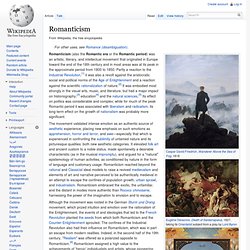
The importance the Romantics placed on untrammelled feeling is summed up in the remark of the German painter Caspar David Friedrich that "the artist's feeling is his law".[7] To William Wordsworth poetry should be "the spontaneous overflow of powerful feelings".[8] In order to truly express these feelings, the content of the art must come from the imagination of the artist, with as little interference as possible from "artificial" rules dictating what a work should consist of. Not essential to Romanticism, but so widespread as to be normative, was a strong belief and interest in the importance of nature. Romanticism. The Norton Anthology of English Literature: The Romantic Age: Topic 2: Overview. The Gothic begins with later-eighteenth-century writers' turn to the past; in the context of the Romantic period, the Gothic is, then, a type of imitation medievalism.
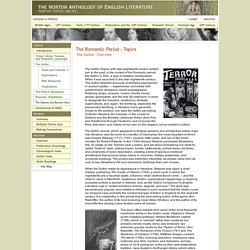
When it was launched in the later eighteenth century, The Gothic featured accounts of terrifying experiences in ancient castles — experiences connected with subterranean dungeons, secret passageways, flickering lamps, screams, moans, bloody hands, ghosts, graveyards, and the rest. The Norton Anthology of English Literature: The Romantic Age: Topic 4: Overview. "Romantic Orientalism" — the second term sometimes expanded to "Oriental exoticism" or "Oriental fantasy" — brings together two concepts that continue to be much in dispute among theorists and literary historians.
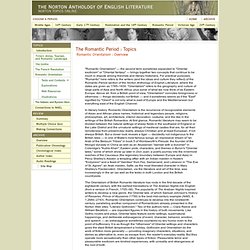
Aestheticism, Homoeroticism, and Christian Guilt in The Picture of Dorian Gray. Nineteenth-Century Fiction, Vol. 24, No. 3 (Dec., 1969), pp. 349-355. In Darkest London : The Gothic Cityscape in Victorian Literature. Dorian_Gray. Framing the Frame: Embedded Narratives, Enabling Texts, and Frankenstein. Prevalent ideas of “frame narrative” often proceed from a reduced metaphoric conception.
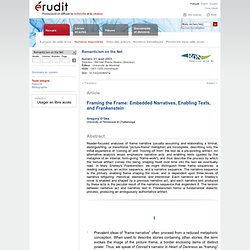
A2 English Literature: Narrative Structure of Frankenstein. Frankenstein is comprised of three narrators - Walton, Victor and the creature.
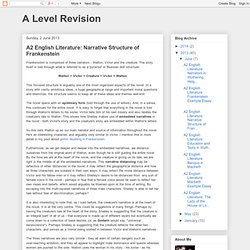
The story itself is told through what is referred to as a 'pyramid' or 'Russian doll' structure: Walton > Victor > Creature > Victor > Walton This focused structure is arguably one of the most organised aspects of the novel. In a story with vastly ambitious ideas, a huge geographical range and important moral questions and dilemmas, the structure seems to keep all of these ideas and themes well-knit.
Higher Bitesize English - Techniques : Revision, Page4. How Charlotte Brontë revolutionised Gothic literature. Jane Austen famously dismissed Gothic literature as stupid (very valid though).
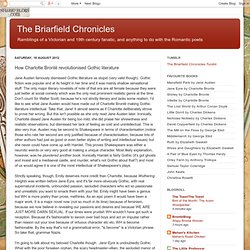
Gothic fiction was popular and at its height in her time and it was mainly shallow sensational stuff. The only major literary novelists of note of that era are all female because they were just better at social comedy which was the only real prominent realistic genre at the time. Don't count Sir Walter Scott, because he's not strictly literary and lacks some realism. I'd like to see what Jane Austen would have made out of Charlotte Brontë making Gothic literature intellectual. Take that, Jane! Lesson 1: Gothic Literature and its Origins. Purpose This lesson introduces you to the basic characteristics and social contexts of gothic literature.
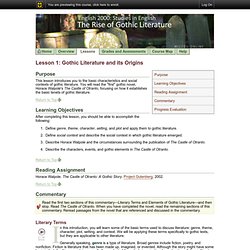
You will read the "first" gothic novel, Horace Walpole's The Castle of Otranto, focusing on how it establishes the basic tenets of gothic literature. Learning Objectives After completing this lesson, you should be able to accomplish the following: Define genre, theme, character, setting, and plot and apply them to gothic literature. The Bildungsroman Genre. Public.wsu.edu/~delahoyd/eyre.doppelganger.html. Richard Juplit English 199 M.
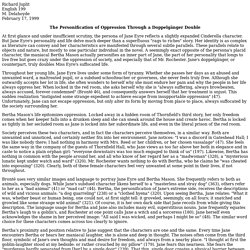
Delahoyde February 17, 1999 The Personification of Oppression Through a Doppelgänger Double At first glance and under insufficient scrutiny, the persona of Jane Eyre reflects a slightly expanded Cinderella character. But Jane Eyre's personality and life delve much deeper than a superfluous "rags to riches" story. Favret, "The Letters of Frankenstein" The Letters of Frankenstein Mary A.
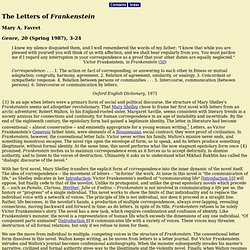
Favret. The Sublime. The Sublime In opposition to the rational thinking of the Enlightenment, Romantics often seek the sublime. Defined"The passion caused by the great and sublime in nature . . . is Astonishment; and astonishment is that state of the soul, in which all its motions are suspended, with some degree of horror. In this case the mind is so entirely filled with its object, that it cannot entertain any other. " Double Dialogues - Issue Ten. The doppelgänger is an uncanny motif comprising two distinct types: (1) the alter ego or identical double of a protagonist who seems to be either a victim of an identity theft perpetrated by a mimicking supernatural presence or subject to a paranoid hallucination; (2) the split personality or dark half of the protagonist, an unleashed monster that acts as a physical manifestation of a dissociated part of the self.
Studies of the motif which consider these types tend to view the difference between them as a formal one only. However, if the two types are treated as distinct perspectives on the theme of identity in crisis, a reading emerges in which, although the doppelgänger motif apparently subverts our notion of identity, it in effect operates in a conservative manner reinforcing the necessity of socialisation. Is the story of Mr. The Castle of Otranto - Analysis of Horace Walpole's Gothic Novel. Literary critics generally agree that Horace Walpole's 1764 novel, The Castle of Otranto, inaugurated an entire genre which would subsequently come to be known as Gothic fiction.
Walpole was the first to employ a range of narrative conventions that would later exert a considerable influence over many other writers. The third son of the statesman Sir Robert Walpole, Horace Walpole was instrumental in both the Gothic revival in architecture and the development of the Gothic novel. He had a keen interest in the gothic styles of the medieval era and successfully attempted to recreate these at Strawberry Hill, his house in London. It was within the Gothic interior of Strawberry Hill where he claimed to have literally dreamt up the idea for Otranto, completing the text in less than two months.
Romance and Realism. Gothic Fiction/ The Horror Novel. Gothic fiction flowered in the 18th and early 19th centuries, notably with the romances of M.G. Lewis and Charles Maturin and Ann Radcliffe. The word Gothic originally meant medieval, but by the end of the 18th century, it came to refer to a literature preoccupied with the macabre. This was a very popular type of fiction -- particularly with women -- between 1790 and 1820. Gothic novelists experimented with a new kind of fiction which dealt primarily with emotional and imaginative awareness and the non-rational, darker side of experience. It was often described as being a type of self-obsessed and claustrophobic type of narrative. Home.mindspring.com/~blkgrnt/footlights/foot51.html.
By Clifford J. Kurkowski Gothic novel or Gothic romance: a story of terror and suspense, usually set in a gloomy old castle or monastery (hence "Gothic," a term applied to medieval architecture and thus associated in the 18th century with superstition). from The Concise Oxford Dictionary of Literary TermsPart I: What Does The Word Gothic Really Mean? During my childhood I remember watching many horror films.
I used to sneak into movie theaters with false proof of identification, saying I was sixteen so I could watch movies like: Dawn of the Dead, Night of the Living Dead, Mother's Day, Faces of Death, and many others. Feminist Criticism of Frankenstein. The Uncanny. Dr. Jekyll and Mr. Hyde. Gothic Elements in 'The Strange Case of Dr Jekyll and Mr Hyde' Class. Wilde, Oscar. Romantik und Ästhetizismus: Festschrift für Paul Gerhard Klussmann. 1) Introduction into Victorian Morality - What exactly was the Victorian Era? Jane eyre: an overview — The Bildungsroman Project. The Gothic Heroine, and the female gothic.
The Chills and Thrills of Gothic Fiction. There’s always been a paradox at the bleeding heart of gothic fiction. We read it in two seemingly contradictory ways: we are caught up in its dark swirl of highly-charged emotions, but sometimes we also stand a little aside from it and derive amusement from its intrinsic absurdity. But what is the Gothic? Like its subject matter, it defies analysis. It’s a description now applied to fiction with elements of horror, the paranormal, science fiction, mystery or melodrama, though rarely all at the same time. Like all genre labels, in other words, ‘gothic’ is a convenient catch-all term rather than a precise definition. The Gothic Novel. David De Vore Anne Domenic Alexandra Kwan Nicole Reidy I. Introduction "Gothic" has come to mean quite a number of things by this day and age. It could mean a particular style of art, be it in the form of novels, paintings, or architecture; it could mean "medieval" or "uncouth.
" It could even refer to a certain type of music and its fans. A. The Goths, one of the many Germanic tribes, fought numerous battles with the Roman Empire for centuries. B. Centuries passed before the word "gothic" meant anything else again. II. The Gothic novel took shape mostly in England from 1790 to 1830 and falls within the category of Romantic literature. As Ann B. The setting is greatly influential in Gothic novels. The Gothic hero becomes a sort of archetype as we find that there is a pattern to their characterization. The plot itself mirrors the ruined world in its dealings with a protagonist's fall from grace as she succumbs to temptation from a villain. III. IV. A. B. Works Cited: Evans, Bertrand. Dreams in Jane Eyre. This essay is Part I of Alan Gordon's "Dreams in Jane Eyre and Wide Sargasso Sea.
" In Darkest London: The Gothic Cityscape in Victorian Literature - Jamieson Ridenhour. Britain, France and the Gothic, 1764-1820: The Import of Terror - Angela Wright. Gothic forms in Jane Eyre.